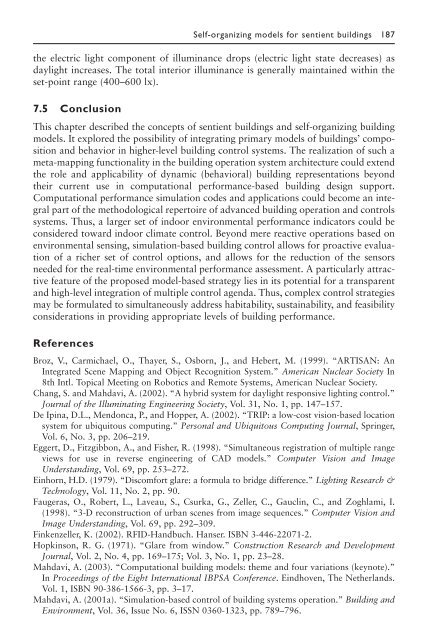Advanced Building Simulation
Advanced Building Simulation
Advanced Building Simulation
Create successful ePaper yourself
Turn your PDF publications into a flip-book with our unique Google optimized e-Paper software.
the electric light component of illuminance drops (electric light state decreases) as<br />
daylight increases. The total interior illuminance is generally maintained within the<br />
set-point range (400–600 lx).<br />
7.5 Conclusion<br />
This chapter described the concepts of sentient buildings and self-organizing building<br />
models. It explored the possibility of integrating primary models of buildings’ composition<br />
and behavior in higher-level building control systems. The realization of such a<br />
meta-mapping functionality in the building operation system architecture could extend<br />
the role and applicability of dynamic (behavioral) building representations beyond<br />
their current use in computational performance-based building design support.<br />
Computational performance simulation codes and applications could become an integral<br />
part of the methodological repertoire of advanced building operation and controls<br />
systems. Thus, a larger set of indoor environmental performance indicators could be<br />
considered toward indoor climate control. Beyond mere reactive operations based on<br />
environmental sensing, simulation-based building control allows for proactive evaluation<br />
of a richer set of control options, and allows for the reduction of the sensors<br />
needed for the real-time environmental performance assessment. A particularly attractive<br />
feature of the proposed model-based strategy lies in its potential for a transparent<br />
and high-level integration of multiple control agenda. Thus, complex control strategies<br />
may be formulated to simultaneously address habitability, sustainability, and feasibility<br />
considerations in providing appropriate levels of building performance.<br />
References<br />
Self-organizing models for sentient buildings 187<br />
Broz, V., Carmichael, O., Thayer, S., Osborn, J., and Hebert, M. (1999). “ARTISAN: An<br />
Integrated Scene Mapping and Object Recognition System.” American Nuclear Society In<br />
8th Intl. Topical Meeting on Robotics and Remote Systems, American Nuclear Society.<br />
Chang, S. and Mahdavi, A. (2002). “A hybrid system for daylight responsive lighting control.”<br />
Journal of the Illuminating Engineering Society, Vol. 31, No. 1, pp. 147–157.<br />
De Ipina, D.L., Mendonca, P., and Hopper, A. (2002). “TRIP: a low-cost vision-based location<br />
system for ubiquitous computing.” Personal and Ubiquitous Computing Journal, Springer,<br />
Vol. 6, No. 3, pp. 206–219.<br />
Eggert, D., Fitzgibbon, A., and Fisher, R. (1998). “Simultaneous registration of multiple range<br />
views for use in reverse engineering of CAD models.” Computer Vision and Image<br />
Understanding, Vol. 69, pp. 253–272.<br />
Einhorn, H.D. (1979). “Discomfort glare: a formula to bridge difference.” Lighting Research &<br />
Technology, Vol. 11, No. 2, pp. 90.<br />
Faugeras, O., Robert, L., Laveau, S., Csurka, G., Zeller, C., Gauclin, C., and Zoghlami, I.<br />
(1998). “3-D reconstruction of urban scenes from image sequences.” Computer Vision and<br />
Image Understanding, Vol. 69, pp. 292–309.<br />
Finkenzeller, K. (2002). RFID-Handbuch. Hanser. ISBN 3-446-22071-2.<br />
Hopkinson, R. G. (1971). “Glare from window.” Construction Research and Development<br />
Journal, Vol. 2, No. 4, pp. 169–175; Vol. 3, No. 1, pp. 23–28.<br />
Mahdavi, A. (2003). “Computational building models: theme and four variations (keynote).”<br />
In Proceedings of the Eight International IBPSA Conference. Eindhoven, The Netherlands.<br />
Vol. 1, ISBN 90-386-1566-3, pp. 3–17.<br />
Mahdavi, A. (2001a). “<strong>Simulation</strong>-based control of building systems operation.” <strong>Building</strong> and<br />
Environment, Vol. 36, Issue No. 6, ISSN 0360-1323, pp. 789–796.

















